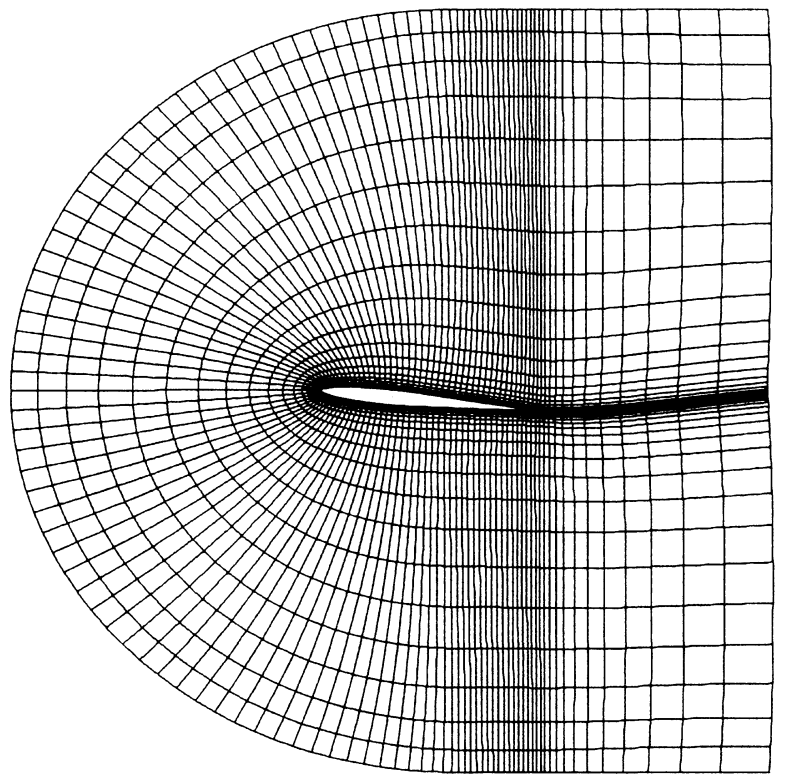2022-10-03 2D Advection-diffusion and waves
Contents
2022-10-03 2D Advection-diffusion and waves#
Last time#
Implicit Runge-Kutta methods
Exploring/discussing tradeoffs
SciML benchmarks suite (
DifferentialEquations.jl)
Today#
FD methods in 2D
Cost profile
The need for fast algebraic solvers
Wave equation and Hamiltonians
Symplectic integrators
using Plots
default(linewidth=3)
using LinearAlgebra
using SparseArrays
function my_spy(A)
cmax = norm(vec(A), Inf)
s = max(1, ceil(120 / size(A, 1)))
spy(A, marker=(:square, s), c=:diverging_rainbow_bgymr_45_85_c67_n256, clims=(-cmax, cmax))
end
function plot_stability(Rz, title; xlims=(-2, 2), ylims=(-2, 2))
x = LinRange(xlims[1], xlims[2], 100)
y = LinRange(ylims[1], ylims[2], 100)
heatmap(x, y, (x, y) -> abs(Rz(x + 1im*y)), c=:bwr, clims=(0, 2), aspect_ratio=:equal, title=title)
end
struct RKTable
A::Matrix
b::Vector
c::Vector
function RKTable(A, b)
s = length(b)
A = reshape(A, s, s)
c = vec(sum(A, dims=2))
new(A, b, c)
end
end
function rk_stability(z, rk)
s = length(rk.b)
1 + z * rk.b' * ((I - z*rk.A) \ ones(s))
end
rk4 = RKTable([0 0 0 0; .5 0 0 0; 0 .5 0 0; 0 0 1 0], [1, 2, 2, 1] / 6)
function ode_rk_explicit(f, u0; tfinal=1., h=0.1, table=rk4)
u = copy(u0)
t = 0.
n, s = length(u), length(table.c)
fY = zeros(n, s)
thist = [t]
uhist = [u0]
while t < tfinal
tnext = min(t+h, tfinal)
h = tnext - t
for i in 1:s
ti = t + h * table.c[i]
Yi = u + h * sum(fY[:,1:i-1] * table.A[i,1:i-1], dims=2)
fY[:,i] = f(ti, Yi)
end
u += h * fY * table.b
t = tnext
push!(thist, t)
push!(uhist, u)
end
thist, hcat(uhist...)
end
ode_rk_explicit (generic function with 1 method)
Extending advection-diffusion to 2D#
1 dimension#
Cell Peclet number \(\mathrm{Pe}_h = \frac{\lvert w \rvert h}{\kappa}\)
\(\mathrm{Pe}_h \lesssim 1\) avoids oscillations
\(\mathrm{Pe}_h \gtrsim 1\) is non-stiff for time-dependent model
Centered versus upwind for advection
Need uniformly bounded \(\kappa \ge \epsilon > 0\)
“Strong form” not defined at discontinuities in \(\kappa\)
Works okay using divergence form and fluxes at staggered points
2 dimensions#
\(\Omega\) is some well-connected open set (we will assume simply connected) and the Dirichlet boundary \(\Gamma_D \subset \partial \Omega\) is nonempty.
Finite difference methods don’t have an elegant/flexible way to specify boundaries
We’ll choose \(\Omega = (-1, 1) \times (-1, 1)\)
On finite difference grids#
Non-uniform grids can mesh “special” domains
Rare in 3D; overset grids, immersed boundary methods
Concept of staggering is complicated/ambiguous



Time-independent advection-diffusion#
Advection#
If we choose divergence-free \(\mathbf w\), we can use the stencil
Diffusion#
When would you trust this decomposition?
If we have constant \(\kappa\), we can write
\[\begin{split} -\kappa \nabla\cdot \nabla u \approx \frac{\kappa}{h^2} \begin{bmatrix} & -1 & \\ -1 & 4 & -1 \\ & -1 & \end{bmatrix} \!:\! \begin{bmatrix} u_{i-1, j+1} & u_{i, j+1} & u_{i+1,j+1} \\ u_{i-1, j} & u_{i, j} & u_{i+1,j} \\ u_{i-1, j-1} & u_{i, j-1} & u_{i+1,j-1} \\ \end{bmatrix} \end{split}\]
Advection-diffusion in code#
function advdiff_matrix(n; kappa=1, wind=[1, 1]/sqrt(2))
h = 2 / n
rows = Vector{Int64}()
cols = Vector{Int64}()
vals = Vector{Float64}()
idx(i, j) = (i-1)*n + j
stencil_advect = [-wind[1], -wind[2], 0, wind[1], wind[2]] / h
stencil_diffuse = [-1, -1, 4, -1, -1] * kappa / h^2
for i in 1:n
for j in 1:n
if i in [1, n] || j in [1, n]
push!(rows, idx(i, j))
push!(cols, idx(i, j))
push!(vals, 1.)
else
append!(rows, repeat([idx(i,j)], 5))
append!(cols, [idx(i-1,j), idx(i,j-1), idx(i,j), idx(i+1,j), idx(i,j+1)])
append!(vals, stencil_advect + stencil_diffuse)
end
end
end
sparse(rows, cols, vals)
end
advdiff_matrix (generic function with 1 method)
Spy the matrix#
A = advdiff_matrix(6, wind=[1, 0], kappa=.001)
my_spy(A)
A = advdiff_matrix(20, wind=[2, 1], kappa=.1)
ev = eigvals(Matrix(-A))
scatter(real(ev), imag(ev))
scatter!([0], [0], color=:black, label=:none, marker=:plus)
Plot a solution#
n = 50
x = LinRange(-1, 1, n)
y = x
f = cos.(pi*x/2) * cos.(pi*y/2)'
heatmap(x, y, f, aspect_ratio=:equal)
A = advdiff_matrix(n, wind=[2,1], kappa=.001)
u = A \ vec(f)
heatmap(x, y, reshape(u, n, n), aspect_ratio=:equal)
What happens when advection dominates?
As you refine the grid?
Cost breadown and optimization#
using ProfileSVG
function assemble_and_solve(n)
A = advdiff_matrix(n)
x = LinRange(-1, 1, n)
f = cos.(pi*x/2) * cos.(pi*x/2)'
u = A \ vec(f)
end
@profview assemble_and_solve(400)
┌ Warning: The depth of this graph is 96, exceeding the `maxdepth` (=50).
│ The deeper frames will be truncated.
└ @ ProfileSVG /home/jed/.julia/packages/ProfileSVG/ecSyU/src/ProfileSVG.jl:275
┌ Warning: The depth of this graph is 96, exceeding the `maxdepth` (=50).
│ The deeper frames will be truncated.
└ @ ProfileSVG /home/jed/.julia/packages/ProfileSVG/ecSyU/src/ProfileSVG.jl:275
What’s left?#
Symmetric Dirichlet boundary conditions
Symmetric Neumann boundary conditions
Verification with method of manufactured solutions
Non-uniform grids
Upwinding for advection-dominated problems
Variable coefficients
Time-dependent problems
Fast algebraic solvers
Gas equations of state#
There are many ways to describe a gas
Name |
variable |
units |
|---|---|---|
pressure |
\(p\) |
force/area |
density |
\(\rho\) |
mass/volume |
temperature |
\(T\) |
Kelvin |
(specific) internal energy |
\(e\) |
energy/mass |
entropy |
\(s\) |
energy/Kelvin |
Equation of state#
Ideal gas#
pressure(rho, T) = rho*T
contour(LinRange(0, 2, 30), LinRange(0, 2, 30), pressure, xlabel="\$\\rho\$", ylabel="\$T\$")
Conservation equations#
Mass#
Let \(\mathbf u\) be the fluid velocity. The mass flux (mass/time) moving through an area \(A\) is
If mass is conserved in a volume \(V\) with surface \(A\), then the total mass inside the volume must evolve as
where we have applied the divergence theorem. Dropping the integrals over arbitrary volumes, we have the evolution equation for conservation of mass.
Momentum#
The momentum \(\rho \mathbf u\) has a flux that includes
convection \(\rho \mathbf u \otimes \mathbf u\)
this is saying that each component of momentum is carried along in the vector velocity field
pressure \(p I\)
viscous \(-\boldsymbol\tau\)
A similar integral principle leads to the momentum equation
